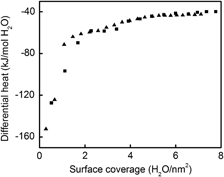Crossref Citations
This article has been cited by the following publications. This list is generated based on data provided by
Crossref.
Navrotsky, Alexandra
2011.
Nanoscale Effects on Thermodynamics and Phase Equilibria in Oxide Systems.
ChemPhysChem,
Vol. 12,
Issue. 12,
p.
2207.
Spencer, Elinor C.
Ross, Nancy L.
Parker, Stewart F.
Kolesnikov, Alexander I.
Woodfield, Brian F.
Woodfield, Kellie
Rytting, Mckay
Boerio-Goates, Juliana
and
Navrotksy, Alexandra
2011.
Influence of Particle Size and Water Coverage on the Thermodynamic Properties of Water Confined on the Surface of SnO2 Cassiterite Nanoparticles.
The Journal of Physical Chemistry C,
Vol. 115,
Issue. 43,
p.
21105.
Costa, Gustavo C. C.
Saradhi Maram, Pardha
Navrotsky, Alexandra
and
Vanderah, T.
2012.
Thermodynamics of Nanoscale Lead Titanate and Barium Titanate Perovskites.
Journal of the American Ceramic Society,
Vol. 95,
Issue. 10,
p.
3254.
Castro, Ricardo H. R.
and
Quach, Dat V.
2012.
Analysis of Anhydrous and Hydrated Surface Energies of gamma-Al2O3 by Water Adsorption Microcalorimetry.
The Journal of Physical Chemistry C,
Vol. 116,
Issue. 46,
p.
24726.
Szabó, Dorothée Vinga
Kilibarda, Goran
Schlabach, Sabine
Trouillet, Vanessa
and
Bruns, Michael
2012.
Structural and chemical characterization of SnO2-based nanoparticles as electrode material in Li-ion batteries.
Journal of Materials Science,
Vol. 47,
Issue. 10,
p.
4383.
Shi, Quan
Boerio-Goates, Juliana
Woodfield, Kellie
Rytting, Mckay
Pulsipher, Katie
Spencer, Elinor C.
Ross, Nancy L.
Navrotsky, Alexandra
and
Woodfield, Brian F.
2012.
Heat Capacity Studies of Surface Water Confined on Cassiterite (SnO2) Nanoparticles.
The Journal of Physical Chemistry C,
Vol. 116,
Issue. 6,
p.
3910.
Ma, Yuanyuan
Navrotsky, Alexandra
and
Vanderah, T.
2012.
Thermodynamics of Nanocrystalline Sn0.586Ti0.414O2 Rutile Solid Solution: Comparison with Nanocrystalline SnO2 and TiO2 and with Bulk Materials.
Journal of the American Ceramic Society,
Vol. 95,
Issue. 8,
p.
2622.
Quach, Dat V.
Bonifacio, Abigail R.
and
Castro, Ricardo H. R.
2013.
Water adsorption and interface energetics of zinc aluminate spinel nanoparticles: Insights on humidity effects on nanopowder processing and catalysis.
Journal of Materials Research,
Vol. 28,
Issue. 15,
p.
2004.
Maram, Pardha S.
Costa, Gustavo C. C.
and
Navrotsky, Alexandra
2013.
Experimental Confirmation of Low Surface Energy in LiCoO2 and Implications for Lithium Battery Electrodes.
Angewandte Chemie,
Vol. 125,
Issue. 46,
p.
12361.
Maram, Pardha S.
Costa, Gustavo C. C.
and
Navrotsky, Alexandra
2013.
Experimental Confirmation of Low Surface Energy in LiCoO2 and Implications for Lithium Battery Electrodes.
Angewandte Chemie International Edition,
Vol. 52,
Issue. 46,
p.
12139.
Wu, Di
Gassensmith, Jeremiah J.
Gouvêa, Douglas
Ushakov, Sergey
Stoddart, J. Fraser
and
Navrotsky, Alexandra
2013.
Direct Calorimetric Measurement of Enthalpy of Adsorption of Carbon Dioxide on CD-MOF-2, a Green Metal–Organic Framework.
Journal of the American Chemical Society,
Vol. 135,
Issue. 18,
p.
6790.
Birkner, Nancy
Nayeri, Sara
Pashaei, Babak
Najafpour, Mohammad Mahdi
Casey, William H.
and
Navrotsky, Alexandra
2013.
Energetic basis of catalytic activity of layered nanophase calcium manganese oxides for water oxidation.
Proceedings of the National Academy of Sciences,
Vol. 110,
Issue. 22,
p.
8801.
Wang, Hsiu-Wen
Wesolowski, David J.
Proffen, Thomas E.
Vlcek, Lukas
Wang, Wei
Allard, Lawrence F.
Kolesnikov, Alexander I.
Feygenson, Mikhail
Anovitz, Lawrence M.
and
Paul, Rick L.
2013.
Structure and Stability of SnO2 Nanocrystals and Surface-Bound Water Species.
Journal of the American Chemical Society,
Vol. 135,
Issue. 18,
p.
6885.
Sahu, Sulata K.
Maram, Pardha S.
Navrotsky, Alexandra
and
Vanderah, T.
2013.
Thermodynamics of Nanoscale Calcium and Strontium Titanate Perovskites.
Journal of the American Ceramic Society,
Vol. 96,
Issue. 11,
p.
3670.
Ma, Yuanyuan
Qu, Yongquan
and
Zhou, Wei
2013.
Surface engineering of one-dimensional tin oxide nanostructures for chemical sensors.
Microchimica Acta,
Vol. 180,
Issue. 13-14,
p.
1181.
Drazin, John W.
and
Castro, Ricardo H. R.
2014.
Water Adsorption Microcalorimetry Model: Deciphering Surface Energies and Water Chemical Potentials of Nanocrystalline Oxides.
The Journal of Physical Chemistry C,
Vol. 118,
Issue. 19,
p.
10131.
Guenther, Gerrit
and
Guillon, Olivier
2014.
Solid state transitions of Bi2O3nanoparticles.
Journal of Materials Research,
Vol. 29,
Issue. 12,
p.
1383.
Chang, Chi-Hsiu
and
Castro, Ricardo H.R.
2014.
Surface and grain boundary energies of tin dioxide at low and high temperatures and effects on densification behavior.
Journal of Materials Research,
Vol. 29,
Issue. 9,
p.
1034.
Wang, Hsiu-Wen
DelloStritto, Mark J.
Kumar, Nitin
Kolesnikov, Alexander I.
Kent, Paul R. C.
Kubicki, James D.
Wesolowski, David J.
and
Sofo, Jorge O.
2014.
Vibrational Density of States of Strongly H-Bonded Interfacial Water: Insights from Inelastic Neutron Scattering and Theory.
The Journal of Physical Chemistry C,
Vol. 118,
Issue. 20,
p.
10805.
Drazin, John W.
Castro, Ricardo H.R.
and
Suvaci, E.
2016.
Phase Stability in Calcia‐Doped Zirconia Nanocrystals.
Journal of the American Ceramic Society,
Vol. 99,
Issue. 5,
p.
1778.
